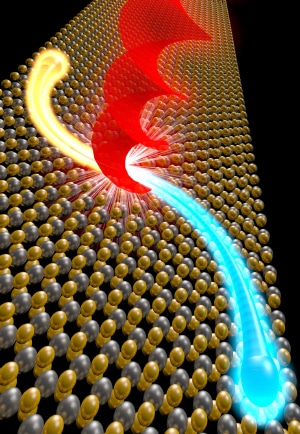Researchers at Cornell University have identified and tested a semiconducting compound that could outdo silicon in terms of performance, and could signal the emergence of a new kind of transistor material in electronics.
The findings, compiled in the paper, “The Valley Hall Effect in MoS2 Transistors,” published recently in Science, revealed promising conductive capabilities of the compound, an atomically thin crystal of molybdenum disulfide.
Molybdenum disulfide has garnered attention from the scientific research community partially from the same buzz that surrounded graphene, a form of pure carbon arranged in a one-atom-thick layer or lattice. Graphene is remarkable for its thinness, strength, and powerful conductive capabilities. However, it makes a poor transistor material, as it cannot switch currents on-and-off easily.

In contrast, because of a special property known as a “valley” – a property that, according to a recent news release in The Cornell Chronicle, produces a “perpendicular, chargeless current that does not dissipate any energy as it flows” – molybdenum disulfide has the capability of being a much more effective transistor material than graphene. Additionally, molybdenum disulfide is easy to acquire, easy to slice into thin crystals, and possesses the necessary band gap to make it an effective semiconductor.
According to Kin Fai Mak, a postdoctoral fellow at the Kavli Institute at Cornell for Nanoscale Science and lead author of the study, if scientists could harness the capabilities of the valley current, molybdenum disulfide could “form the basis for a near-perfect, atomically thin transistor, which in principle would allow electronics to dissipate no heat.”
“Our demonstration of the coupling between the electronic motion and the valley DOF in a 2D semiconductor and its sensitivity to photon polarization represents an important advance for both fundamental condensed matter physics and the emerging area of valley-dependent electronics,” the study reported.
Mak, along with co-authors Paul McEuen, a professor of physics, Jiwoong Park, associate professor of chemistry and chemical biology, and physics graduate student Kathryn McGill, designed a molybdenum disulfide transistor at Cornell’s NanoScale Science and Technology Facility. Their experiments, detailed in their Science report, involved illuminating the transistor with circularly polarized light, which excited electrons into a sideways curve.
The researchers are confident that their findings on molybdenum disulfide could pave exciting new paths in the field of electronic design and development.
“Our observation of VHE opens up new possibilities for using the valley DOF as an information carrier in next-generation electronics and optoelectronics,” the study asserted.
– Melanie Abeygunawardana





